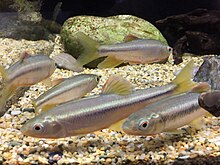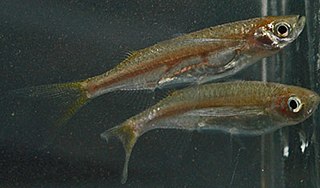
Parachela is a genus of freshwater ray-finned fish belonging to the family Xenocyprididae, the East Asian minnows or sharpbellies. These fishes are found in Asia.

Carassius is a genus in the ray-finned fish family Cyprinidae. Most species in this genus are commonly known as crucian carps, though that term often refers specifically to C. carassius. The most well known species is the goldfish. They have a Eurasian distribution, apparently originating further to the west than the typical carps.
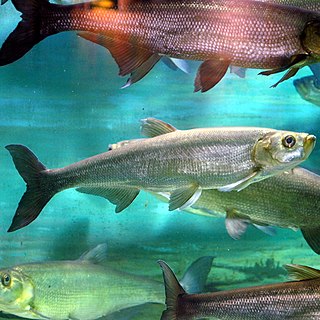
Chanodichthys is a genus of freshwater ray-finned fishes belonging to the family Xenocyprididae, the East Asian minnows or sharpbellies. The species in this genus are found in Eastern Asia. The name is derived from the Greek word chanos, meaning "abyss, mouth opened, inmensity", and the Greek word ichthys, meaning "fish". Chanodichthys is closely related to Culter and some species have been moved between these genera.
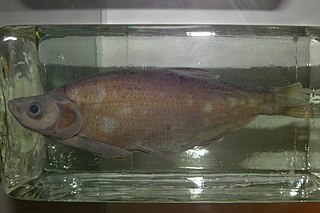
Culter is a genus of freshwater ray-finned fishes belonging to the family Xenocyprididae, the East Asian minnows or sharpbellies. The fishes in thsi genus are found in eastern Asia from Siberia to Viet Nam. The name is derived from the Latin word culter, meaning "knife". Culter is closely related to Chanodichthys and some species have been moved between these genera.

Hemiculter is a genus of freshwater ray-finned fish belonging to the family Xenocyprididae, the East Asian minnows or sharpbellies. The species in this genusare found in eastern Asia from Siberia to Viet Nam. The type species is the sharpbelly, Culter leucisculus. The name is derived from the Greek word hemis, meaning "half", and the Latin word culter, meaning "knife".
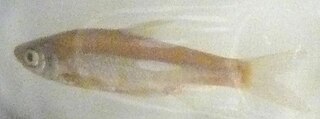
Ischikauia is a monospecific genus of freshwater ray-finned fish belonging to the family Xenocyprididae, the East Asian minnows or sharpbellies. The only species in the genus is Ischikauia steenackeri, the wataka, which is endemic to Lake Biwa in Japan. This species was originally described as Opsariichthys steenackeri.
The white Amur bream is a species of freshwater ray-finned fish belonging to the family Xenocyprididae, the East Asian minnows or sharpbellies This is the only species in the monospecific genus Parabramis. It is native to eastern Asia, where found from the Amur River basin in Russia south to Ningbo and Shanghai in China. It is an important food fish, and has been introduced to regions outside its native range.
Araiocypris is a monospecific genus of freshwater ray-finned fish belonging to the family Xenocyprididae, the East Asian minnows or sharpbellies. The only species in the genus is Araiocypris batodes, a very small fish endemic to Vietnam.

Candidia is a genus of freshwater ray-finned fishes belonging to the family Xenocyprididae. This is a small genus with two valid species, all of which are endemic to Taiwan.
Hainania serrata, also known as the Hainan minnow, is a species of freshwater ray-finned fish belonging to the family Xenocyprididae. the East Asian minnows or sharpbellies. This fish is found in fast flowing hill streams in southern China and Vietnam. It is the only member of the genus Hainania.
Hemiculterella is a genus of freshwater ray-finned fishes belonging to the family Xenocyprididae, the East Asian minnows or sharpbellies. The fishes in this genus occur in eastern Asia. There are currently three species in this genus.
Luciobrama is a monospecific genus of freshwater ray-finned fish belonging to the family Xenocyprididae, the East Asian minnows or sharpbellies. The only species in the genus is Luciobrama macrocephala, the long spiky-head carp, a fish that is found in China and Vietnam. It is classified as data deficient by the IUCN. It is found in rivers and lakes. Larger fish, over 30 centimetres (12 in) live nearer the bottom and the smaller specimens are found higher in the water column. They are partially migratory. It has not been recorded from four of its known spawning sites since 1988.
Ochetobius is a monospecific genus of freshwater ray-finned fish belonging to the family Xenocyprididae, the East Asian minnows or sharpbellies. The only species in the genus is Ochetobius elongatus, a fish found in eastern Asia.

Opsariichthys is a genus of freshwater ray-finned fish belonging to the family Xenocyprididae, the East Asian minnows or sharpbellies found in freshwater habitats in Mainland China, Taiwan, Japan, Korea, and Vietnam.

Oxygaster is a genus of freshwater ray-finned fish belonging to the family Xenocyprididae, the East Asian minnows or sharpbellies. The species in this genus are found in Southeast Asia.
Paralaubuca s a genus of freshwater ray-finned fish belonging to the family Xenocyprididae, the East Asian minnows or sharpbellies. The species in this genus are found in Asia.

Parazacco is a monospecific genus of freshwater ray-finned fish belonging to the family Xenocyprididae, the East Asian minnows or sharpbellies. The only species in the genus is Parazacco spilurus, the predaceous chub, a fish found in China and Vietnam. The International Union for Conservation of Nature has classified this species as Data Deficient but Parazacco fasciatus, now regarded as a synonym of P. spilurus, is classified as being Least Concern.
The smallscale yellowfin is a species of freshwater ray-finned fish belonging to the family Xenocyprididae, the East Asian minnows or sharpbellies. This species is found from the southern part of the Amur drainage systems, including the Ussuri and Lake Khanka, and along the major river drainages of China south to the Xi River in southwestern China and northern Viet Nam. The smallscale yellowfin has a maximum published total length of 70 cm (28 in). This species was first formally described in 1872 as Plagiognathus jelskii by the Polish naturalist and physician Benedykt Dybowski with its type locality given as Lake Khanka and the Ussuri River. Dybowski's genus name was objectively invalid as it was preoccuppied by by Plagiognathus Fieber, 1858 in Hemiptera and in 1907 Lev Berg proposed the genus name Plagiognathops for this taxon.

Nipponocypris sieboldii is a species of freshwater ray-finned fish belonging to the family Xenocyprididae, the East Asian minnows or sharpbellies. that is endemic to Japan. It has a maximum length of 12.5 centimetres (4.9 in).

Nipponocypris temminckii, the dark chub, is a species of freshwater ray-finned fish belonging to the family Xenocyprididae, the East Asian minnows or sharpbellies. It inhabits China, Japan and Korea and has a maximum length of 15.0 centimetres (5.9 in).
